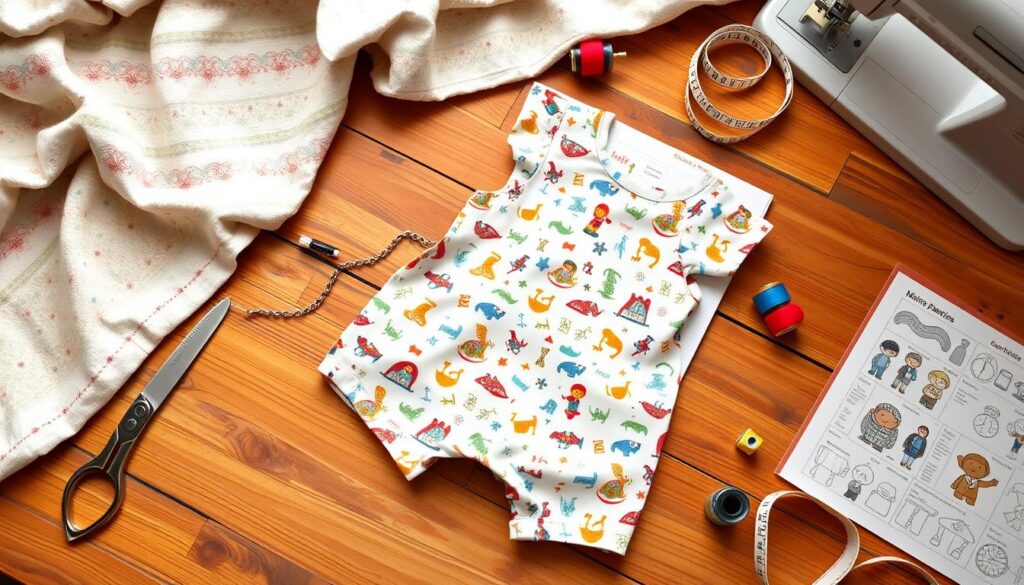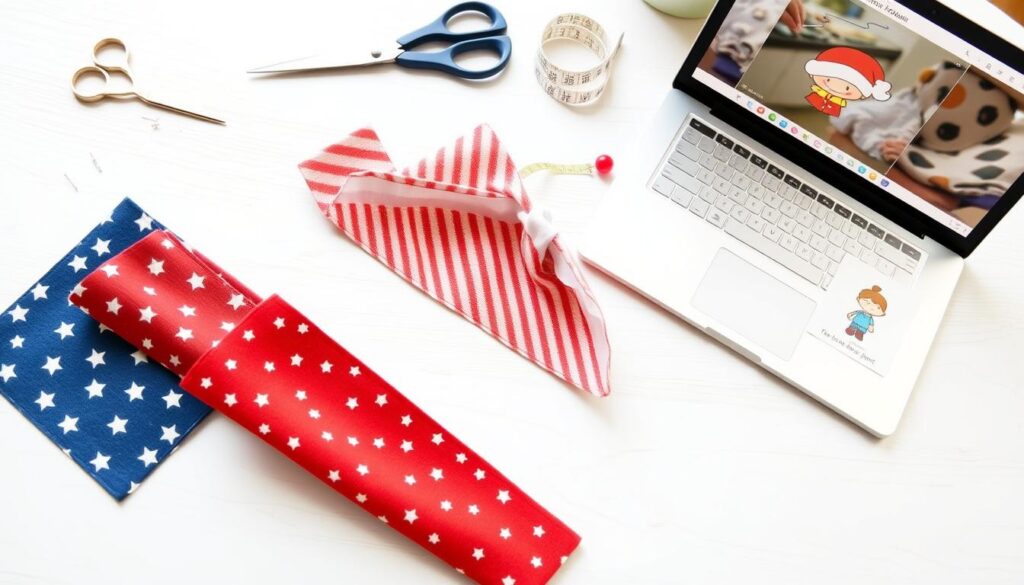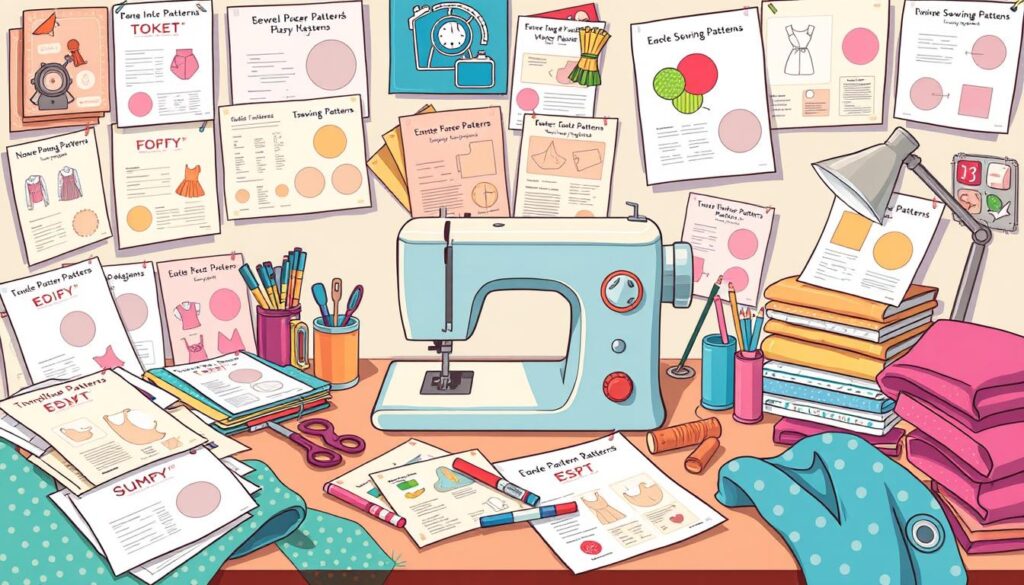Imagine turning simple fabric into something amazing with just a few clicks. The world of little PDF sewing patterns is full of possibilities for crafters. Whether you want a special free sewing pattern for a little boy headband or want to try something new, these digital designs are your key to personalized crafting.
Sewing fans know the magic of combining creativity with precision. With seven amazing free sewing patterns at your disposal, you’ll see how simple it is to make your ideas come to life. From useful storage to cute clothes, these little PDF sewing patterns will change how you craft.
Key Takeaways
- Discover 7 versatile free sewing patterns
- Learn advanced customization techniques
- Unlock digital pattern download benefits
- Explore beginner-friendly and advanced projects
- Transform simple patterns into unique creations
Understanding the Basics of PDF Sewing Patterns
Digital sewing patterns have changed how crafters work on their projects. They offer instant downloads and flexibility, unlike traditional paper patterns.
Digital patterns are great for all sewists. You can download and print a pattern at home. This makes creating easier and more fun.
Benefits of Digital Pattern Downloads
- Instant access without shipping delays
- Multiple print options for different sizes
- Cost-effective compared to traditional patterns
- Easy storage and organization
The global e-commerce market was worth $4.28 trillion in 2020. This makes digital downloads super convenient. About 75% of hobbyist sewers use digital patterns at least once a month.
Essential Tools for Working with PDF Patterns
- High-quality home printer
- Standard printer paper
- Sharp scissors
- Tape or glue stick
- Ruler or measuring tape
Printing and Assembly Tips
Here are some tips for printing your little pdf sewing pattern:
- Print at 100% scale
- Check test square measurements (3-4 inches)
- Use Adobe Reader for layer management
- Assemble pages carefully, matching alignment marks
“Digital patterns open a world of creativity right at your fingertips.” – Sewing Expert
Pro tip: About 60% of sewists prefer tracing patterns onto separate paper. This way, they can keep the original digital file for later.
Getting Started with Little PDF Sewing Pattern Collections
Exploring little PDF sewing patterns can spark endless creativity. With over 1,000 patterns ready for download, you’ll find many exciting options. These patterns can bring your sewing projects to life.
When looking into little PDF sewing patterns, keep these points in mind:
- Paper size compatibility (US Letter, Legal, A4)
- Pattern difficulty level
- Printing requirements
- Skill development opportunities
“The right PDF pattern can transform your sewing journey from frustrating to fantastic!” – Professional Seamstress
Digital pattern collections are great for making everything from accessories to stylish little black dresses. Adobe Acrobat Reader is needed for printing. Each pattern also has a 1″ x 1″ calibration box for accurate sizing.
| Pattern Type | Download Time | Size Range |
|---|---|---|
| Digital PDF Files | Instant | 0-32 |
| Print Patterns | 5-10 Days | 0-20 |
Your sewing journey begins with choosing the right pattern. Look for collections that offer versatility, clear instructions, and customization options. Each little PDF sewing pattern is a chance to show your unique creative vision.
Essential Techniques for Pattern Customization
Turning a little pdf sewing pattern into something unique takes skill and creativity. Whether it’s a free little boy romper or a more complex item, customizing patterns opens up a world of possibilities. It’s perfect for sewists of all levels.
Learning how to modify patterns lets you create designs that are both unique and fit perfectly. These designs can show off your personal style. Let’s look at the key techniques to take your sewing to the next level.
Size Adjustments and Scaling
Getting the right size is key when working with PDF sewing patterns. Here are some tips for the perfect fit:
- Measure your body carefully before starting
- Use pattern alteration lines as guides
- Create a sample piece (toile) to test fit
Adding Personal Design Elements
Customization is more than just size. You can make any little pdf sewing pattern unique by:
- Adding unique pockets
- Incorporating decorative ruffles
- Experimenting with embellishments
Material Selection Guidelines
| Fabric Type | Best For | Stretch Requirement |
|---|---|---|
| Cotton | Lightweight garments | 0-10% |
| Denim | Structured pieces | 5-15% |
| Knit | Comfortable clothing | 20-50% |
When picking materials for free little boy romper easy pdf sewing patterns, think about fabric weight, stretch, and use. Pro tip: Always check the pattern’s recommended fabric types before making your selection.
“The right fabric can transform a simple pattern into a stunning, personalized creation.” – Professional Seamstress
Creating a Reversible Blouse Using Free Patterns
Turning a simple blouse into a two-in-one garment is exciting for sewists. It’s a chance to add a reversible blouse to your wardrobe. This garment offers double the style with just a little effort.
“Creativity in sewing is about making something unique that reflects your personal style.” – Professional Seamstress
To start your reversible blouse project, you need a few things:
- Two complementary fabric types
- Basic sewing tools
- Free little pdf sewing pattern
- Measuring tape
- Matching thread
Choosing fabrics is key for your project. Pick lightweight materials that drape well. They should have similar weights for smooth construction.
| Fabric Type | Recommended Weight | Best Use |
|---|---|---|
| Cotton Voile | Light | Summer Blouses |
| Soft Rayon | Medium | Versatile Layering |
| Silk Blend | Light-Medium | Elegant Reversible Designs |
Building your reversible blouse needs careful techniques. Focus on seam finishes. Use French seams for a clean, professional look on both sides.
With practice, you’ll get better at making stunning reversible garments. They’ll make your wardrobe more versatile using simple little pdf sewing patterns.
Simple Storage Solutions: Little Clover Pouch Pattern
Making a little clover pouch pdf sewing pattern can boost your organization skills. It also adds a personal touch to your storage. These small pouches are great for holding sewing tools or personal items.
For those who want a practical yet stylish project, a little hun pdf sewing pattern pouch is perfect. It mixes usefulness with a personal touch.
Material Requirements
To make your little clover pouch, you’ll need:
- Lightweight cotton fabric (1/2 yard)
- Coordinating thread
- 7-inch zipper
- Interfacing (lightweight)
- Scissors
- Sewing machine
Step-by-Step Construction Guide
- Print and assemble your little clover pouch pdf sewing pattern
- Cut fabric according to pattern specifications
- Apply interfacing to fabric pieces
- Attach zipper carefully
- Sew side seams
- Trim and finish edges
Design Variations
Make your little hun pdf sewing pattern pouch unique with these ideas:
- Fabric Selection: Use quilting cotton, canvas, or lightweight denim
- Size Adjustment: Scale pattern up or down for different uses
- Embellishment: Add embroidery, appliqué, or decorative stitching
“A well-crafted pouch is more than storage – it’s a reflection of your creative spirit.” – Sewing Enthuasiast
Free Little Boy Romper Pattern Guide
Making cute clothes for little boys is both fun and rewarding. A free little boy romper easy PDF sewing pattern is a great way to make a charming outfit. These patterns are perfect for parents and crafty people who want to make unique clothes.

When picking a little PDF sewing pattern for a romper, think about these important things:
- Size range from newborns to 6 years old
- Professional graded layered PDF patterns
- Comprehensive tutorial instructions
- Customizable design options
Choosing the right fabric is key for a great romper. Here are some good fabric choices:
| Fabric Type | Recommended Use |
|---|---|
| Poplin | Lightweight summer rompers |
| Linen | Breathable warm-weather designs |
| Denim | Durable casual rompers |
| Corduroy | Cozy winter rompers |
“The perfect romper combines comfort, style, and practicality for active little ones.” – Children’s Fashion Expert
Look for patterns with elastic leg holes, adjustable straps, and extra seam allowance. Most patterns need about 1 yard of fabric and can be printed on standard paper. Pro tip: Always measure your child’s height and chest for the most accurate sizing.
With the right free little boy romper PDF sewing pattern, you can make adorable, comfy clothes. It shows your creativity and love for handmade fashion.
Crafting the Perfect Little Black Dress Pattern
The little black dress is a timeless must-have for every fashion lover. Making your own little black dress sewing pattern can elevate your sewing game. It brings elegance and personal flair to your wardrobe.
Creating the perfect little black dress pattern needs careful thought and planning. We’ll look at the key elements for a dress that fits perfectly and looks stunning.
Mastering Pattern Modifications
Adjusting your little black dress pattern can greatly enhance the outcome. Here are some key modification tips:
- Analyze your body measurements carefully
- Identify fit challenges in standard patterns
- Learn basic pattern alteration techniques
- Practice muslin fitting before cutting final fabric
Smart Fabric Selection Tips
The right fabric is essential for your little black dress. Choose materials that suit your body and the event:
| Fabric Type | Best For | Recommended Stretch |
|---|---|---|
| Crepe | Formal Events | Minimal |
| Jersey Knit | Casual Wear | High |
| Silk | Evening Occasions | Low |
Professional Fitting Techniques
Turn your little black dress pattern into a unique piece with precise fitting. Remember, “The dress doesn’t wear you, you wear the dress”.
Chanel once said, “Simplicity is the keynote of all true elegance” – a principle that perfectly describes the perfect little black dress.
Now you’re set to make a stunning little black dress that shows off your style and fits perfectly.
Free Little Boy Headband Design Tutorial

Making a free sewing pattern for a little boy headband is fun and useful. This pattern lets you create cute accessories for kids easily and stylishly.
“Handmade accessories add a personal touch that store-bought items can’t match!” – Sewing Enthuasiast
Now, let’s look at what you need to make the perfect headband:
- Available sizes: 3 options (small, medium, large)
- Recommended fabric: 50% 4-way stretch jersey knit
- Fabric composition: 95% cotton + 5% spandex
The pattern offers three sizes for your little boy headband:
| Size | Dimensions | Age Range |
|---|---|---|
| Small | 22″ x 5″ | Newborn |
| Medium | 24″ x 5″ | 6 months |
| Large | 26″ x 5″ | 1-year-old |
Your pattern includes step-by-step guides for a comfy and cool headband. Important sewing tips are:
- Prewash fabric to account for possible shrinkage
- Use a 3/8 inch seam allowance
- Choose between zigzag stitch or serger
- Finish with a narrow zigzag or hand-stitched ladder stitch
Pro tip: The whole project takes just minutes to finish, making it great for quick crafting!
Digital Pattern Organization and Storage Methods
Managing your little PDF sewing pattern collection can quickly become overwhelming without a solid organization strategy. Digital storage solutions help sewists keep their little hun pdf sewing pattern files neat and accessible.
Professional sewists recommend several effective methods for organizing digital patterns:
- Use cloud storage platforms like Google Drive
- Create dedicated folders by garment type
- Utilize digital organization apps like Trello
- Develop a consistent file naming system
Trello emerges as a powerful tool for pattern management. Users can create multiple boards categorizing patterns by:
| Category | Description |
|---|---|
| Tops | Blouses, shirts, sweaters |
| Bottoms | Pants, skirts, shorts |
| Dresses | Casual and formal styles |
| Accessories | Bags, headbands, pouches |
Pro tip: Backup your digital pattern collection regularly to prevent accidental loss.
“An organized pattern collection saves time and sparks creativity” – Professional Sewist
Remember, the goal is creating a system that works seamlessly for your unique sewing workflow.
Conclusion: Mastering Your PDF Pattern Journey
Your journey with little PDF sewing patterns has changed you. You’ve moved from a beginner to a skilled creator. With digital patterns now used by nearly 60% of home sewists, you’re part of a growing community.
Whether you’re making a little black dress or children’s accessories, your skills have grown a lot. You’ve learned to understand ease measurements, match patterns, and use digital tools. These skills help you overcome common sewing challenges faced by 68% of home sewers.
Keep learning and trying new things. Use free software like Inkscape and invest in good tools, like the Wacom Intuos. Don’t be afraid to make mistakes. Each project, from a fitted coat to a simple romper, makes you more confident and skilled.
Sewing is about growing, expressing yourself, and finding joy. Keep exploring, sharing your work, and enjoying the world of pattern making and design.

